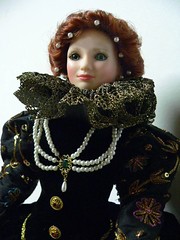 |
Queen Elizabeth I Candy Spelling Fantasy Doll by Barbara Beccio |
| Originally uploaded by mharrsch. |
American doll artist Barbara Beccio designed this Candy Spelling series doll for Madame Alexander in 1995. Her beautifully detailed costume reflects Barbara's Masters of Fine Art in costume and lighting design from New York University where she garnered the Seidman Award for Excellence in Design.
She had previously been nominated In 1994 for the Dolls Award of Excellence for "Jacqueline" one of Effanbee's collection of Victorian dolls called "The Ladies of Elegance . (I have several of these as well in my collection and they are quite stunning!)
"Her costuming also garnered another nomination for a Dolls of Excellence Award for "Amethyst", produced by Kingstate. A recreation of a Dewees Cochran American Child doll outfit won a Dolls of Excellence Award for Effanbee Doll Company and was featured as one of the Dolls for the Classic American Dolls Commemorative Stamps. She also designs Doll clothes for Ashton-Drake Galleries, as well as re-creating gowns for their Princess Diana Series." - The Hospice Mask Project

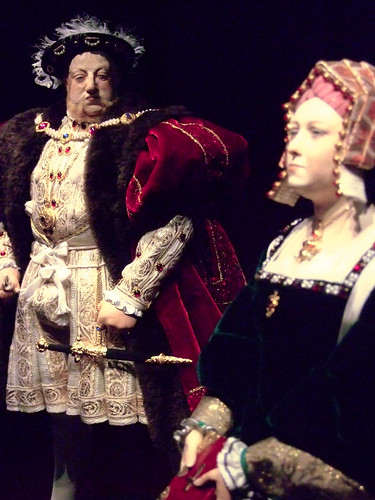
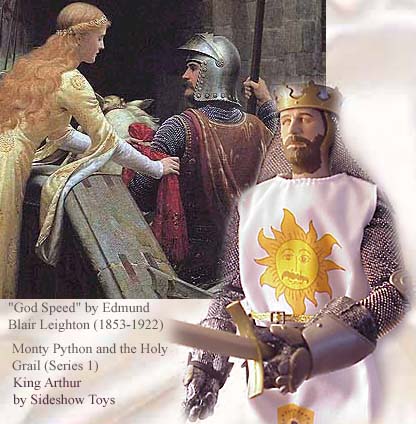
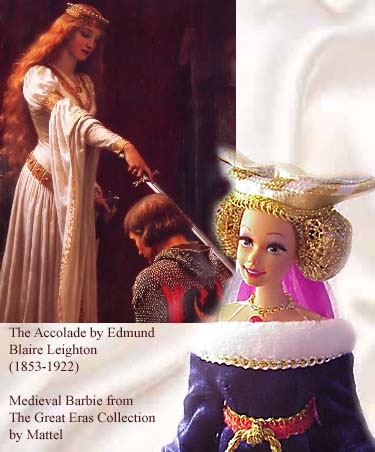
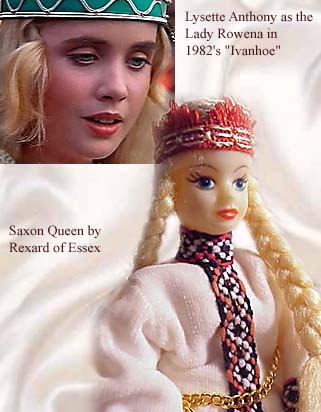
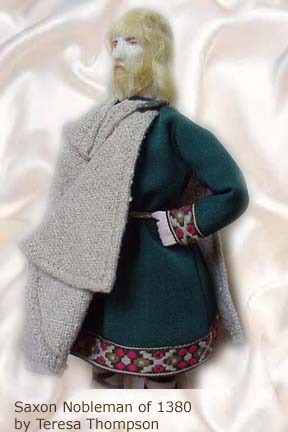 ose worn by men. Wealthy noblewomen might have broad borders of embroidery or braid at the cuffs and hem of these dresses, and in some cases another broad band running from the neck to the hem at centre front. In the case of extremely wealthy women the entire tunic may have been of patterned cloth or covered in embroidery. This tunic was cut very wide, and was probably based on the tunica colobium or tunica dalmatica of late Roman and Byzantine fashion. In England this garment was referred to as a cyrtel, although the Latin loan word tunica was borrowed into English as tunece."
ose worn by men. Wealthy noblewomen might have broad borders of embroidery or braid at the cuffs and hem of these dresses, and in some cases another broad band running from the neck to the hem at centre front. In the case of extremely wealthy women the entire tunic may have been of patterned cloth or covered in embroidery. This tunic was cut very wide, and was probably based on the tunica colobium or tunica dalmatica of late Roman and Byzantine fashion. In England this garment was referred to as a cyrtel, although the Latin loan word tunica was borrowed into English as tunece."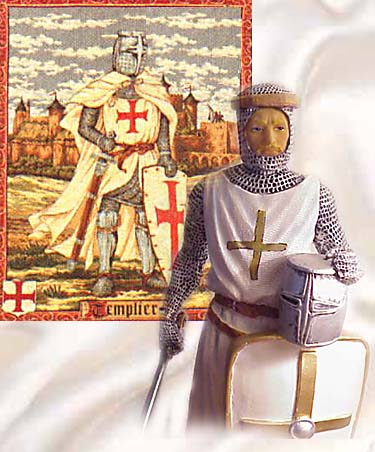 ms, but generally had a long, wide, straight, double-edged blade with a simple cross-guard (or "cruciform" hilt). The typical form was a single hand weapon used for hacking, shearing cuts and also for limited thrusting which evolved from the Celtic and Germanic swords of late Antiquity. Over time, the sword became more tapered and rigid, to facilitate thrusting, and began to add a series of protective rings to the hilt, to defend the fingers and hand. This was the birth of the "cut and thrust" or "sidesword."
ms, but generally had a long, wide, straight, double-edged blade with a simple cross-guard (or "cruciform" hilt). The typical form was a single hand weapon used for hacking, shearing cuts and also for limited thrusting which evolved from the Celtic and Germanic swords of late Antiquity. Over time, the sword became more tapered and rigid, to facilitate thrusting, and began to add a series of protective rings to the hilt, to defend the fingers and hand. This was the birth of the "cut and thrust" or "sidesword."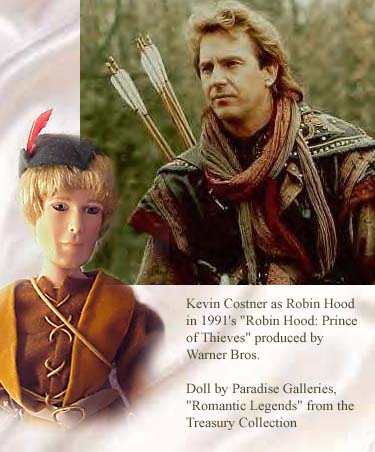 Another popular figure from the Middle Ages is
Another popular figure from the Middle Ages is 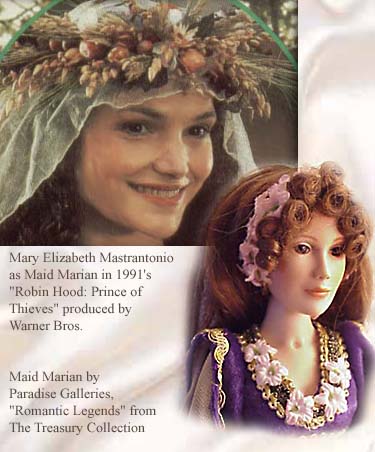 n.
n.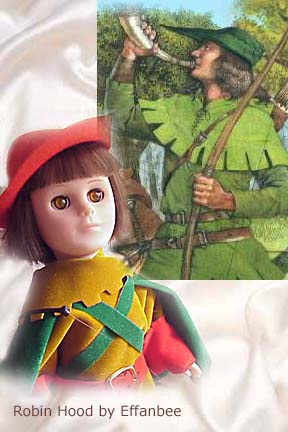 John, disguised as Reynolde Grenlefe, greets the sheriff who is hunting in the forest and "knelyd hym beforne" (line 729). When Little John tells the sheriff that he has just seen "a ryght fayre harte" (line 738) and a herd of deer, he foolishly asks to be taken to the spot where Robin, "the mayster-herte" (line 753), awaits him. After dining with the outlaw band, the sheriff is stripped of his clothing and forced to sleep on the ground. Begging to be released the next morning, he swears an oath that he will not harm Robin or his men in the future. Upon being released, he, humiliated but unharmed, returns to Nottingham where he
John, disguised as Reynolde Grenlefe, greets the sheriff who is hunting in the forest and "knelyd hym beforne" (line 729). When Little John tells the sheriff that he has just seen "a ryght fayre harte" (line 738) and a herd of deer, he foolishly asks to be taken to the spot where Robin, "the mayster-herte" (line 753), awaits him. After dining with the outlaw band, the sheriff is stripped of his clothing and forced to sleep on the ground. Begging to be released the next morning, he swears an oath that he will not harm Robin or his men in the future. Upon being released, he, humiliated but unharmed, returns to Nottingham where he 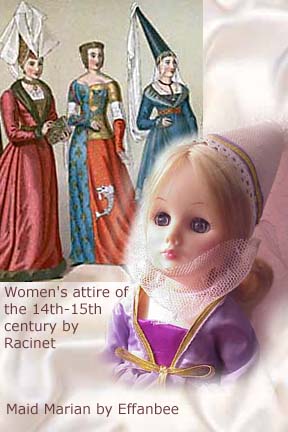 breaks his oath by plotting to capture Robin at the archery tournament."
breaks his oath by plotting to capture Robin at the archery tournament."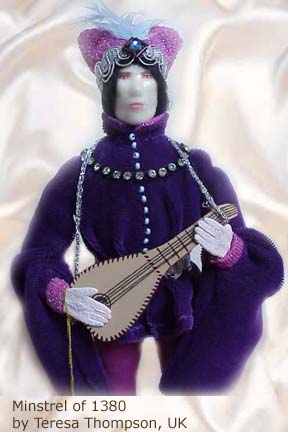 Wandering bards and minstrels also made their appearance in the Middle Ages. The first troubador poet was the grandfather of Eleanor of Aquitaine. Poets often recited tales of courtly love where gallant knights fought bravely to impress a lady that was unattainable because she was already married or betrothed.
Wandering bards and minstrels also made their appearance in the Middle Ages. The first troubador poet was the grandfather of Eleanor of Aquitaine. Poets often recited tales of courtly love where gallant knights fought bravely to impress a lady that was unattainable because she was already married or betrothed. 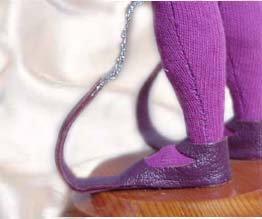
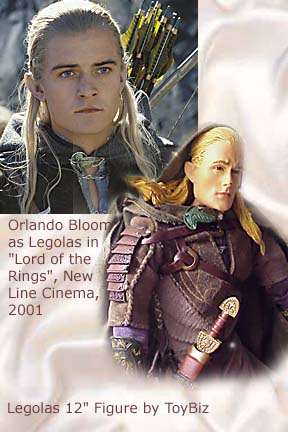 Actually, one of the most realistic costume I have found on a doll -- or uuhumm - "action figure", graces a character from a parallel period, Middle Earth instead of the Middle Ages. The intricately detailed clothing for ToyBiz's 12 inch figure of Legolas from "Lord of the Rings: The Fellowship of the Ring" is exceptional. In the film, Legolas' archery skills certainly looked like they equalled those of Robin Hood. I do wish the figure would have had rooted hair, however. His long, pale blonde hair was one of his most attractive features. I guess "guys" would have thought it made the piece too much like a doll instead of the more masculine "action figure".
Actually, one of the most realistic costume I have found on a doll -- or uuhumm - "action figure", graces a character from a parallel period, Middle Earth instead of the Middle Ages. The intricately detailed clothing for ToyBiz's 12 inch figure of Legolas from "Lord of the Rings: The Fellowship of the Ring" is exceptional. In the film, Legolas' archery skills certainly looked like they equalled those of Robin Hood. I do wish the figure would have had rooted hair, however. His long, pale blonde hair was one of his most attractive features. I guess "guys" would have thought it made the piece too much like a doll instead of the more masculine "action figure".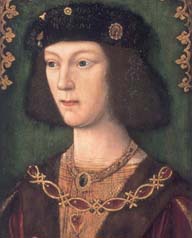
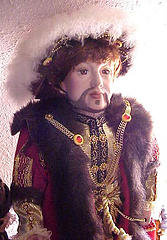
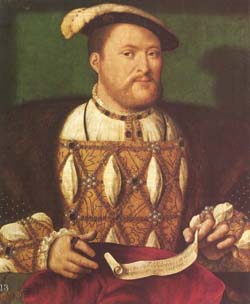 to the
actual women in Henry's life. They are beautiful however and
the costumes are lavishly adorned. I was able to purchase Henry
for
less than $30 although I've seen this doll sell for almost $50.
I purchased all six wives for only $22 each.
to the
actual women in Henry's life. They are beautiful however and
the costumes are lavishly adorned. I was able to purchase Henry
for
less than $30 although I've seen this doll sell for almost $50.
I purchased all six wives for only $22 each.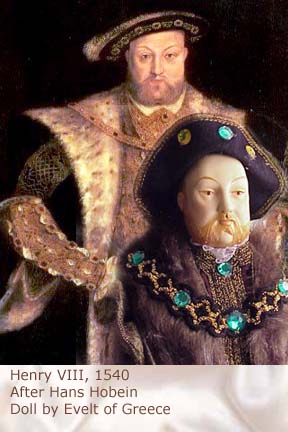 a daughter, Elizabeth.
a daughter, Elizabeth.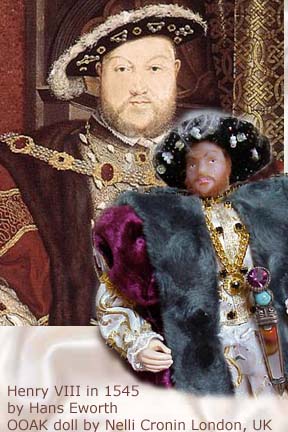 Ebay has opened up a whole world to doll collectors. I was the
successful bidder for a wonderfully detailed one-of-a-kind (OOAK)
Elizabeth I doll created by Nelli Cronin and she mentioned she
also had made a Henry VIII and all of his wives that I readily agreed
to buy as well. Nelli is originally from St. Petersburg, Russia
and is now married to an Englishman and lives in London. Her
finely
detailed Henry VIII is about 8" tall and is adorned with a
real human hair beard. Nelli visits Madame Toussaud's Wax Museum
and uses the wax figures there as models for some of her dolls.
Ebay has opened up a whole world to doll collectors. I was the
successful bidder for a wonderfully detailed one-of-a-kind (OOAK)
Elizabeth I doll created by Nelli Cronin and she mentioned she
also had made a Henry VIII and all of his wives that I readily agreed
to buy as well. Nelli is originally from St. Petersburg, Russia
and is now married to an Englishman and lives in London. Her
finely
detailed Henry VIII is about 8" tall and is adorned with a
real human hair beard. Nelli visits Madame Toussaud's Wax Museum
and uses the wax figures there as models for some of her dolls.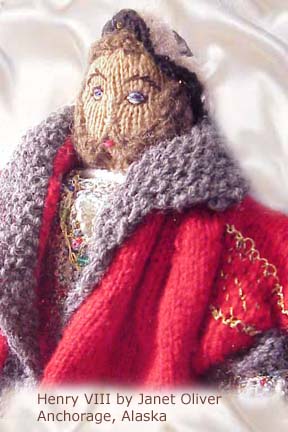

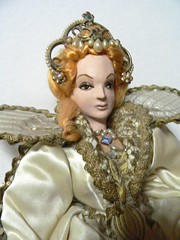 With
all this attention throughout history, it is not surprising that I found
so many different reincarnations of Elizabeth
in the doll world. Probably my most rare Queen Elizabeth doll is a portrait
doll by Ilse Ottenberg. Ilse and her German husband, Richard, were interned
as enemy aliens on the Isle of Man at the outbreak of World War II. To
occupy their time there, the Ottenbergs began making toys
With
all this attention throughout history, it is not surprising that I found
so many different reincarnations of Elizabeth
in the doll world. Probably my most rare Queen Elizabeth doll is a portrait
doll by Ilse Ottenberg. Ilse and her German husband, Richard, were interned
as enemy aliens on the Isle of Man at the outbreak of World War II. To
occupy their time there, the Ottenbergs began making toys 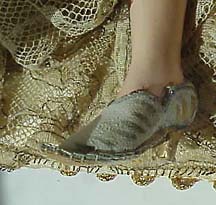 and soon involved
other internees in their work. After the war, the Ottenbergs turned toy
making into their primary livelihood. At the time of Queen Elizabeth
II's
coronation, Ilse submitted a commemorative doll to Buckingham Palace
for the Queen's approval for a franchise of dolls depicting the Royals
and
was one of only two dollmakers who were granted the license. Ottenberg's
dolls are highly detailed. Even the heeled shoes Elizabeth I wears are
carefully hand stitched.
and soon involved
other internees in their work. After the war, the Ottenbergs turned toy
making into their primary livelihood. At the time of Queen Elizabeth
II's
coronation, Ilse submitted a commemorative doll to Buckingham Palace
for the Queen's approval for a franchise of dolls depicting the Royals
and
was one of only two dollmakers who were granted the license. Ottenberg's
dolls are highly detailed. Even the heeled shoes Elizabeth I wears are
carefully hand stitched. 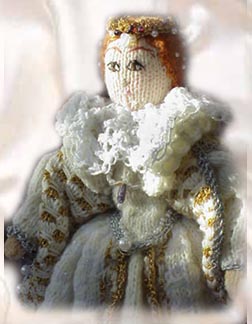 Ottenberg
dolls have been displayed at a number of British Embassies throughout
the world. I feel very fortunate to have obtained one of these dolls on
Ebay for a price of only $80. I continue to search for them (especially
her Cleopatra or Nefertiti dolls).
Ottenberg
dolls have been displayed at a number of British Embassies throughout
the world. I feel very fortunate to have obtained one of these dolls on
Ebay for a price of only $80. I continue to search for them (especially
her Cleopatra or Nefertiti dolls). 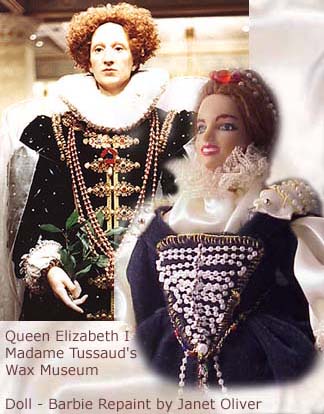 Janet's
Elizabeth Barbie is lavishly decorated with pearls, a trademark of the
this warrior queen. Sir Roy Strong in his book "
Janet's
Elizabeth Barbie is lavishly decorated with pearls, a trademark of the
this warrior queen. Sir Roy Strong in his book "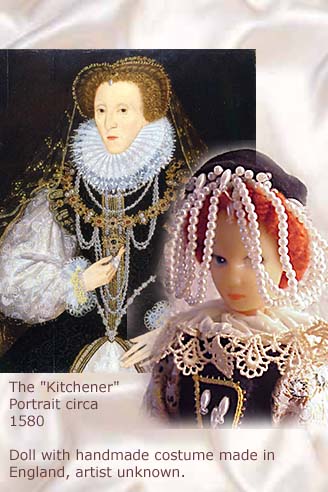
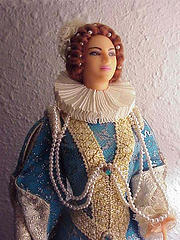 have
the broad smile of one of Marin's dancers and their hands are usually
in the same expressive pose. However, this rendition of Elizabeth draped
in her trademark pearls was more subdued although the queen would have
approved of the hands. Sir Roy Strong observes, "The Queen was particular
proud of her hands and contemporary accounts describe her making much
of taking her gloves off and often she is posed in portraits with her
hands gesturing or resting in front of her chest."
have
the broad smile of one of Marin's dancers and their hands are usually
in the same expressive pose. However, this rendition of Elizabeth draped
in her trademark pearls was more subdued although the queen would have
approved of the hands. Sir Roy Strong observes, "The Queen was particular
proud of her hands and contemporary accounts describe her making much
of taking her gloves off and often she is posed in portraits with her
hands gesturing or resting in front of her chest." 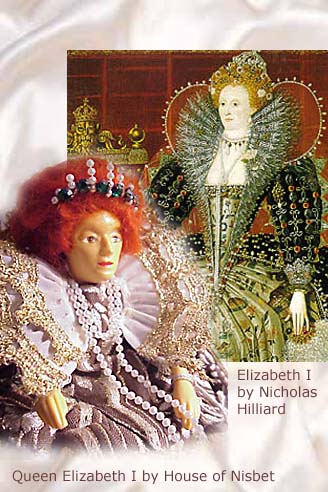 wonder
if she would have approved? Strong writes, "Her policing and concern
over her image was reflected in the Privy Council's order in 1596 to destroy
all portraits of her which were to her 'great offence'. Sir Walter Raleigh
in The History of the World of 1687 describes the works of 'common Painters'
being thrown in the fire. As a result we are justify with a smaller number
of iconic portraits; interesting because of their fine quality and because
they survived the Queen's rigorous editing. We are presented with images
of the Queen fashioned in the way she wished to be presented and make
her unmistakable."
wonder
if she would have approved? Strong writes, "Her policing and concern
over her image was reflected in the Privy Council's order in 1596 to destroy
all portraits of her which were to her 'great offence'. Sir Walter Raleigh
in The History of the World of 1687 describes the works of 'common Painters'
being thrown in the fire. As a result we are justify with a smaller number
of iconic portraits; interesting because of their fine quality and because
they survived the Queen's rigorous editing. We are presented with images
of the Queen fashioned in the way she wished to be presented and make
her unmistakable."
No comments:
Post a Comment